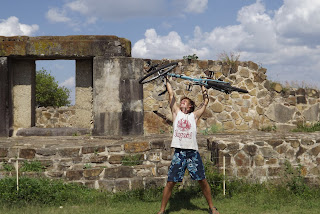There are some people you meet on the road (cyclists I mean) that swear they've been going strong for 2 years when in fact they've been riding for just a couple of months. With each biking hour dragging on like a snagged disc brake, there are certainly plenty of times on especially long desolate stretches of highways where the sun seems to get stuck at the highest point in the sky around eleven in the morning and doesn't budge until the latest hours of the afternoon, at which point you begin a frantic search for shelter before shithoused truck drivers start their eight o clock death race to the next town before their favorite novella comes on. I've counted a solid seven months on the road since departing Cordooboo, and despite the various tricks the mind plays when one spends every waking moment biking for hours on end, it feels like I turned my back on the beautiful folks of Argentina barely two weeks ago. My voyage has delivered me safely into the loving arms of Mexico, arguably the historical heart and soul of North America, and in Mormon mythology, the location where Jesus dyed the first Jewish Mexicans brown from sin, while the chosen white people--pure of heart and pigment--almost certainly perished of skin cancer (long live Satan). At this rate, Mexico's going to fly by in less than a second, which is sad, because I'm a few days into this country and I'm loving this place.
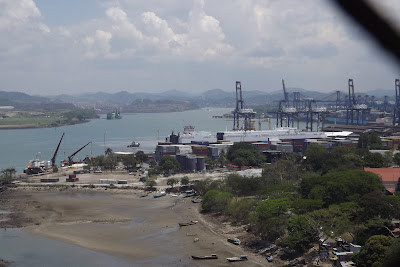 |
| That's two less cranes than the port of Oakland (Panama City) |
Sometimes the time warp effect can be a mercy, especially when you're looking at 300 km's of flat, forgettable, Central American highway with little more to offer the needy traveler than the occasional comedor that's out of everything except chicharron, which is awesome. I don't mean to rag on Panama in two consecutive posts, especially since I spent almost a week biking around a pretty big land mass, but with Argentinian hobo cyclists trying to steal my thunder and one of the biggest cities in Central America offering nothing in terms of spare shifter cables or a safe place to bike around, I wasn't looking to spend more time than I had to.
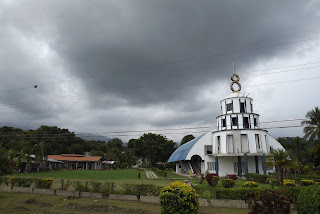 |
| Church of Pretzelquotli (Rio Claro, Costa Rica) |
Just as soon as I was getting used to day after day of endless flat, Costa Rica drops on me like a tropical brick out of nowhere and suddenly I found myself weaving through the jungle ride at Disney Land, complete with monkeys and macaws but sans aggressive animatronic hippos and hostile natives. What's not great about this place? Weary foreigners always seem to mention the extravagant prices of everything in this jungle paradise (things cost about the same as they do in the states, and tipping is expected just about everywhere), but come strapped with a tent, a hammock, and a disarming smile, you can get away with staying pretty much anywhere for nothing, and with the amount of prime beachfront camping from north to south, it would be a crime not to exploit what these lands have to offer in terms of prime real estate.
 |
| Non photogenic Costa Rican monkeys (what the locals call "maize") |
 |
| Macaws exhibitting curiosity, a behavior the locals call "maize" |
I also had one distinct advantage over other travelers in these parts...with my incredibly vast network of friends and fellow adventurers, it would be nothing short of a cosmic fluke if I did not run across some pals somewhere along the way back to California. It was by sheer luck that I came across fellow high school survivors Will Clark and Matt Hay in Playa Hermosa, the perfect surf town if there ever was one. Within a weeks time, I was finally goaded into jumping into the ocean with a slab of fiberglass beneath me, and while I did not stand, I definitely slid over the surf with the grace of a penguin. Meanwhile, I was put to shame by Will and Matt and fellow surfers who turned tsunami sized mammoths into half pipes in seconds.
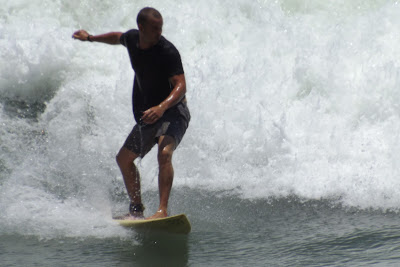 |
| Will Clark shredding gnar, a custom locals dub"maize" |
Despite all the various American conveniences Costa Rica had to offer, it definitely did not have the best roads for cycling. Shoulders were rare, and with roads just wide enough to accommodate the width of a bus and maybe a jallopy, the danger of clippage was extremely high. If that wasn't enough, some punk ass prison snitch beach bum stole my sweaty three-day-old-ball-and-butt-sweat-soaked shorts and the pouch for my sleeping bag in the port town of Caldera. I cannot describe how strong my thirst for revenge was after that incident, and yet the bastard left nary a clue safe for a few tiny lady like footprints in the sand. Clearly not man enough to face me in waterside combat.
 |
Roadside howler monkeys
searching branches for maize |
After a few more towns and keeping myself relatively intact on the Costa Rican roads (save for a hit and run accident that left me with a crooked fork), it was onto Nicaragua and another mind blowing revelation--I was now in a part of the world where I was passing into new countries in a matter of days. A more dedicated student of anthropology or languages might be able to discern the cultural differences that go into all this central American separation, but for me, the reason was pretty clear. No single country blended seemlessly into the other (with the exception of maybe El Salvador and Guatemala), with each border crossing marked by evident changes in landscape and climate. While Costa Rica was a pretty much a giant rain forest, the west coast of Nicaragua was like Southern Californian hill country in the middle of an especially dry summer. Honduras marked the return of wet jungle lands, and El Salvador served as an small introduction to the dramatic ascents that would define the voyage through Guatemala, but I am getting way ahead of myself.
 |
| Jinotepe |
 |
| Leon |
As far as conveniences go, Nicaragua pretty much had all the same things to offer as Costa Rica, minus the stateside price. The pizza in Jinotepe was pretty decent, as were the folks. Sandinistas rule this land with the same level of malevolence as Canadian mounties in Nova Scotia, and even though popular politics around these parts is firmly alligned against various influences from G8 nations, nobody here holds your nationality against you, so some frank and polite conversations about politics and economics can still be had. However, I was not above in partaking in some classic celebration of good ol' American superhuman supremacy when I went to go see the big new expensive comic movie with Shield Man, Spider Woman, Iron Bloke and Mace Windu. It was but a brief taste of things to come once I crossed that sweet sweet border from Tijuana to San Diego. When the explosions subsided and the good guys in the clear, a kid "mistook" me for Nicholas Furious and asked for an autograph. I told him my people need me and fled the scene.
 |
| Birds in El Salvador speak various maize-related phrases |
And so in no time, I was in Honduras. And then in a day's time, I was in El Salvador, a country that I'd spent much time building up great expectations for. I think part of this was due to the fact I had watched Oliver Stone's "Salvador" one too many times and thought I might find relics of the civil war just about everywhere.
 |
| Maize fields -- El Salvador |
That was dopey dumb dumb thinking on my part. The past decade has been marked by relative tranquility and most, if not all folks simply do not want to dedicate a single brain cell to attrocities that occurred less than thirty years ago, resulting in plenty of friendly conversation that were not as educational as I thought they would be. "Oh well," I thought, "I'm sure the big city of San Salvador will have some cool cultural stuff to see". Another dumb move on my part. Instead of checking out the legendary beaches of this country, I head straight for the big city and was once again met by frustration and dissapointment as I tried and failed multiple times to enter the city from various southern routes. Upon finally succeeding after many many hours, I was greated by a city...and that's about it as far as I can tell you. There were lots of people and lots of places for a hamburger or fried chicken and whatnot, and a big ol white house lookin mansion for El Presidente on the outskirts of the city. Sorry folks, but I was just a little dissapointed by the sights. I mean, this city was once the stop over point for all the Spanish treasure in the New World, but I don't think I saw a single relic of ye olden times during my brief say. And so, I was off. One last stop in a Santa Ana gas station had me shooting glass bottles using shotguns and pistols with drunk security guards pretty much all night long. Another potentially underwhelming voyage across parts unknown saved at the last minute by drunken revelry, and for that reason, El Salvador will remain close to my heart.
 |
| Antigua |
And then came Guatemala. By this point in my trip, I had come across maybe 25 cyclists traveling across Mexico and Central America, maybe five of which were doing the whole Alaska to Ushiah trip, none of which reported any problems in this part of the world. Even so, monsignor Clark had previously gifted me with a central American guidebook that made any trek across the Guatemalan frontier seem like a surefire death trap. According to this Lonely Planet guidebook (written in 2009), Guatemala was a land of untamed rogues, scounderals, and gunslingers who wouldn´t hesitate to cap a gringo over some minor disagreement. To pile up on the paranoia roller coaster, a surf shop owner in Costa Rica related to me a story of his first encounter with Guatemalan police who proved to be most unhelpful in his case because they appeared to be huffing some kind of high powered adhesive. Needless to say, I was expecting the worst.

It´s when one expects the worst that one gets the finest, and the people of this fine central American land treated me with practiced deference. The first Guatemalans I approached to get my bearings were two police officers in a solitary station a few kilometers past the boarder crossing, and much to my needless surprise, they were glue free and able to point me in the right direction, expecting nothing more than a grin and a handshake. Somewhere between the frontera and Villa Canales, I ditched the "guidebook" responsible for weighing down my soul with so much fear and anxiety and continued on my rockin way.
 |
| La Merced - Antigua |
After so many rumors and heresay, I was begininning to develop the notion that I should just stop listening to people and experience things for myself. Cyclists from ages past warned me about impassible conditions in the mountains. Backpackers and guidebooks forwarned me of sneak thieves and machete-wielding teenagers eager to make an easy buck off the unwary traveler. However, Guatemala was quickly turning out to be the most incident-free country thus far as far as Central American countries go. Despite the numerous nights camping out between towns and gas stations, nobody here was trying to steal my dirty sweaty shorts or random pouches off drylines. And despite what some cyclists had to say a few months back about the road conditions of this great land, Guatemalan roads were nowhere close to as bad as some of the stories some folks had passed down to me along the way. In fact, for two days, many of the major highways I was taking were closed down to traffic due to one of those long-distance carbon fiber spandex races that are reserved exclusively for those that punish their pernium with unforgiving saddles and spend each and every sexless night in hypobaric chambers. God speed to them, and god bless the freshly paved roads of Guatemala.
 |
| Earthquake ravaged churches in Antigua (not maize related) |
I wasn't trying to take my time either. My crooked front fork had been slowing me down since the accident in Palma Norte, Costa Rica, and I was on a mission to find a replacement. City after town after city, I was met with no such luck and continued to make due with a wheel that was noticeably off tilt until finally reaching the Kabbah box for bike tourists of Central America--
Maya Pedal.
 |
| San Andres Itzapa - Guatemala |
It was here that I managed to slap on a perfect replacement for my bent front fork as well as witness the magic that occurs within the hallowed walls of this world renowned bike shop. Carlos the manager was in the works of fabricating a new pedal-powered corn grinder machine that could potentially sheer an ear of corn maize within seconds with the right pair of legs. This, in addition to pedal powered food processors, laundry machines, and rock tumblers, was but one of the many machinations pioneered by the folks at Maya Pedal over the years, and the folks in San Andres Itzapa appear to be ever greatful for its presence. Local town folk wheelin in with cracked hubs and bent frames have a bike as good as new within a day. As for bike tourists such as myself, the workshop is a cheap place to stay and has all the tools necessary to fix pretty much any problem. It almost has too much stuff to play around with. For example, Carlos made the mistake of showing me how to work the welding tool before he left the shop for the night. I thought I might make my contribution to the friendly folks of San Andres by building a ladder using broken bike frames and rebar, but after going through three of those soddering prongs and two bike frames, I succeeded in making some kind of artistic travesty with the potential to kill a man even if it were used as a door stop, so I tossed the wretched thing and hoped nobody would blame the handywork on me. I bailed the next day to put some distance between me and my creation.
 |
| Panajachel |
And so it came to pass that Guatemala's rainy season kicked into full swing the same day I departed for Panajachel, and the heavens opened up with buckets of cold water, forcing me once again to dawn wintery gear. Nobody seemed to know exactly how to get to Panajachel...the folks at Maya Pedal gave me a route that was only 73km in distance from the workshop, but when I tried taking these backroads, the locals turned me around back onto the freeway, which added about 100km's to a journey that should've taken a few hours. And what a tourist trap Panajachel turned out to be. Not one moment of peace and harmony was had on the lake front with the amount of boat captains trying to hassle you for a ride to the other side of the lake, or the random thing venders trying to sell things of questionable quality. I needed peace, quiet, and a place to dry my wet clothes, and I wasn't going to get it until I left this terrible place. Unfortunately the rains kept coming and kept me soaked to the bone all the way to the border, at which point calm washed over the lands once more.
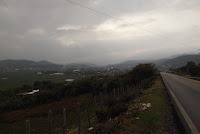 |
| Amatenango |
Ah sweet Mexico, how good it was to finally meet you. The anticipation has been building since my departure from Argentina, for this country would be the last and longest country on my trip before entering California. This time, what I expected is exactly what I got when I crossed the border--an overwhelming feeling of being closer to home, while simultaneously feeling like I was home. A lot of folks were interested in where I was coming from and where I was going. Most mistook me for a deutchlander or Argentino, but as soon as they found out home was California, the spanish was droppped with a
quick high five and stories were exchanged. Pretty much everyone this far south in Mexico (and Guatemala) has worked in California at some point in their lives, or still has family stateside that they're waiting to see again. Pretty much everyone who's had state side experience on the west coast is eager to get back at some point and settle down permanently in hopes to get that treasured American citizenship (protip: it's not that great. At least you can go around the world with a Mexican passport). It all comes down to having a steady job and stability for the family, something that can be difficult to come by for some folks in this part of the world. With all it's natural beauty, rich history, and antique city centers that put every North American city to shame in terms of eye-candy, it's easy to make the mistake of assuming that all's well and everythings on the up and up in this part of the world, and while the quality of life down here is comfortable, there are plenty of folks left behind.
 |
| San Cristobal - maize capital of Chiapas |
Passing through the mountains of Chiapas was like finding myself on some back country trail in Truckee in the middle of spring. In other words, a high alpine paradise that I would consider the perfect temperature for a long day on the road. The air stayed cool all the way to San Cristobal de las Casas, and got down right frigid at night (and here I am, trying to do my best with swim trunks and spandex). Stayed at a dual hostel/bikeshop called
El Hostalito. Cool stay, cool city, and the Museum of Mayan Medicine is something to see if you always wanted to watch an educational video of a Mayan priestess literally squeezing a baby out of a 14 year old girl with a threadbare tourniquet. Something for everyone. Oh, and I learned Bayern, Pfizer, and other big pharma companies, under the auspices of Greenpeace and the World Wildlife Fund, go into these Mayan villages, "patent" the plants these people have been using for thousands of years, and get the local police to prevent the Mayans from harvesting the very same plants for their own purposes. Total bitch move.
 |
| Coastal maize is treasured in Arriaga |
Moving on, my onward voyage towards Oaxaca required a quick trip down to the coast. I learned long ago to dread these mountains-to-coast trips because while one tends to be going downhill, the crippling headwind blowing in from the coast requires frustrating granny gear shifts when I should be flying along at break neck speed. Also, the coast--despite the constant breeze--is home to the hottest weather I've come across since Chamical, Argentina. I got my second case of heat-stroke in my entire trip and had to spend a day resting in Tehuantepec. The climb back up to the mountains was a welcome change as the temperature dropped the higher I climbed. After a quick stop in El Camaron, I finally found myself in the city of Oaxaca.
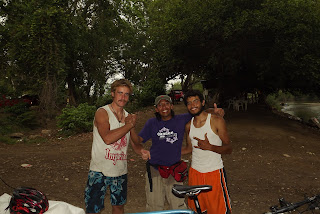 |
| Maize fuels our travels |
While I was aware of the big teachers strike of 2006, and how police had shot and killed a few protesters in cold blood, I had no idea the protests had started up again. Apparently, the agreements made in 2006 were shams. Schools continued to face budget cuts across the board to make way for more private schools (sounds familiar). The teacher killers were not brought to justice, and there were more accusations of extortion and assassinations in the interim. And so, a few months ago, the teachers came back to the city, armed with the same conviction from six years ago, as well as a laundry list of demands for the Oaxacan government.

The scale of this protest puts just about every Occupy protest in the states to shame. Multiple city center streets have effectively closed down to traffic due to the sheer amount of teachers and families camped out in the streets. This has been going on for a few months now, and anytime the police start making a show of force, more teachers flood in from other states in a show of solidarity. Judging by the size and the organization of this particular protest, it looks like this is building up to be another show down on the same par as the previous clash of 06'. We'll see what happens. I wish these folks the best, and I am forever envious of their courage.

Oaxaca remains quite a place to visit. So far, out of all the various cities I've visited in my life, none has an ancient Zapotec temple superstructure sitting at a nearby hilltop and over looking the whole entire valley. This place is flowing with ancient energies I cannot quite put my finger on, but I feel it every morning when my lungs suck in this sweet mountain air (I'm sleeping on a roof at the moment). In fact, I think I'm going to give Monte Alban another bike visit. Too much typing today, not enough sun. I'll tag on some more info later.
 |
| Ancient maize-based death ball court, Monte Alban |
Alright I'm back from my second quick bike trip to Monte Alban. There's not much I can tell you that hasn't already been said on Wikipedia, but I'll try my best...
Joe Rogan and Ron Paul would have you believe these massive structures were planted in Oaxaca long ago by some ancient race of space monkeys, but it's safe to say judging by some of the more extreme examples of obsessive compulsive disorder depicted on one of the countless runestones found throughout the Monte Alban site (you'll see plenty pictures of Zapotec men cutting off their garbage and offering it up to the gods to keep the world turning), I can't think of a better example of a what we might call a "can do attitude".

Archeologists date some of the oldest temple and tomb sites to 500 BC, which makes this one of the oldest relics of an ancient civilization in the western hemisphere. In it's heydey, the place functioned as the commercial and religious center of the various folks living in the surrounding valleys. Folks would travel for miles and miles, climbing the steep hills along the banks of the temple site with heavy bags of maize and maize related goods strapped to their heads (they used buckets made of maize husks). All this effort just to sell their wares to the warrior elite at the top of the mountain.

For one consecutive epoch after another, the old Zapotecs offered up the blood and organs of their enemies to their pantheon of sociopathic gods until the lands below went dry. One can only imagine how horrible it was to live in these end times when the powers that be demanded body after body to be offered up to whatever rain god who wasn't delivering on his/her promise. Eventually the folks below just got tired of walking up and down the hill every day and stopped delivering the goods, letting all the psycho priests starve and cut each other up till there was nothing left but kibble for stray dogs. Anyway, even though the information plates don't tell you much since nobody knows exactly what went on here (except Joe Rogan and Ron Paul), it's one of the most amazing places you'll see in the world. And you can reenact history and actually walk there!
Discovery Channel Discovery of the Week - Gringos abroad
We're lazy, snobbish, incapable of showing deference to the locals, and always demand a room with a working air conditioner. We don't speak Spanish and get angry when the waiter doesn't understand what "chicken" or "Coors" means. When the TV's on at a bar or a restaurant, we change the channel to Fox News or something else with English. We have countless condos on prime beach front property in Costa Rica and have a Nicaraguan "buddy" that can get you a really good deal on another house on the outskirts of Minagua. We'll have one or two local "girlfriends" in Quito and hang around a bit longer than planned before one of the girls tells you she wants to keep it, at which point you'll quickly pack your bags, catch the next connecting flight to Florida, and pray to satan she doesn't start putting pictures up of a blue-eyed Ecuadorian baby on Facebook and tagging you in the photos. We retire in "paradise" because we hate the States, yet we hate it here because it's not the States. We noisely nap on Incan ruins, go skinny dipping in sacred Mayan lagoons, and pee on cathedrals on the way back from a long Friday night. We are gringos abroad, and we want satisfaction!
